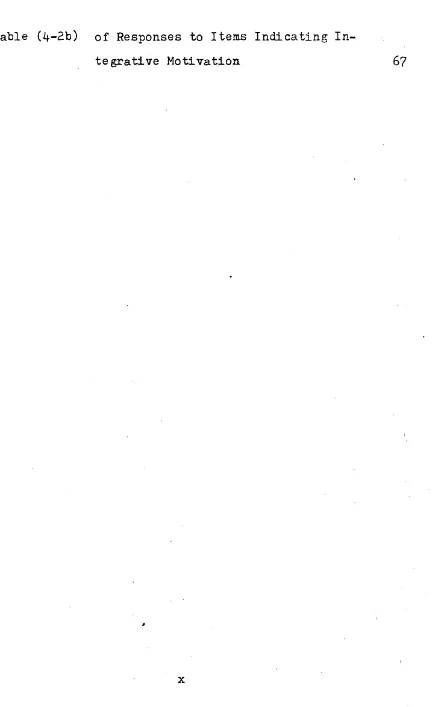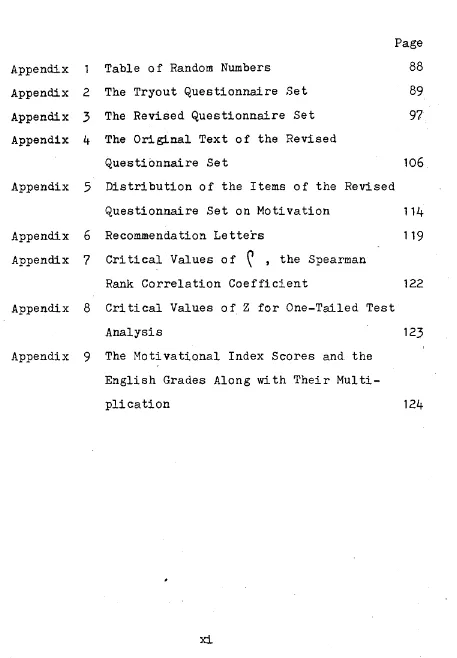THE CORRELATION BETWEEN THE MOTIVATION OF THE FIRST- YEAR
STUDENTS OF SMA IN SURABAYA IN LEARNING ENGLISH
AND THEIR ENGLISH ACHIEVEMENT
A THESIS
Ia Partial Fulfilmmt of tbe Requiremeats for the Sarjana Pendidikan Degree in
English Language Teaching
£epowati
IG. 1213083064
UNIVERSITAS KATOLIK WIDYA MANDALA SURABAYA FAKUL TAS KEGURUAN DAN ILMU PENDIDIKAN
.JURUSAN PENDIDIKAN BAHASA INGGRIS PROGRAM STUDI PENDIDIKAN BAHASA INGGRIS
OCTOBER, 1988
lc (., / L! : ..
~~~·~
.:ll-11-19~
le.p::wot
TT Kl (,
l J\..
,)
APPROVAL SHEET
( 1 )
This thesis entitled -T~h~e ___ c_o~r~r~~~l-a~t~i-o~n--~B_e_t~w_e_e~n--_t_h~e
Motivation of the Fir.st-Year Students of SMA in Surabaya
in Learning English and Their English Achievement
and prepared and submitted by Lepowati Tjengundoro
has been approved and accepted as partial fulfilment of
the requirements for the Sarjana Pendidikan degree in
Eng-lish Language Teaching by the following advisors :
~----·
\ , I
<~~cf1;t~~
Drs. Stefanus Laga Tukan
First Advisor Second Advisor
APPROVAL SHEET
( 2 )
This thesis has been examined by the Comittee on
Oral Examination with a grade of
on November 3. 1988
Drs. A. Guri to
Chairman
··.····
_
.l.·
,
r1
1
L //·-
)
x___
.
Drs. Stefahus Laga~an
t.1ember
---...
Drs. Barto Pramono
B
1 . Member ~ ! 1
\ . ',: \ ,~~ ,: /~
\ ll
[U]v
,
(~rUy
DrarLily Mitra
Member Member
Approved by
Drs. Soeharto
Dean of the
Teacher Training College
Dra. Wuri Soedjatmiko, M.Pd.
Head of the
ACKNOWLEDGEMENTS
The writer woul:! like to thank God for all His
blessing and guidance whi.ch enable her to finish
this thesis.
writing
The writer also wish to express her deepest
grati-tude and cordial thanks to the following persons :
1. Drs. Stefanus Laga Tukan, her first thesis writing ad-visor, whose comments, suggestions, and encouragement
have been of great help to the" writer in accomplishing
this thesis.
2. Dra. Agnes Santi, her second thesis writing advisor, for her valuable suggestions in improving and
this thesis.
3·
All the lecturers of the English Department offinishing
Widya
Mandala University, who patiently taught her du,ring her
study in this Department.
4.
Drs.I.
Nyoman Arcana, who has spent his valuable timeto help the writer with the statistical calculation for
this thesis.
At last, since it is not possible to mention the
names of the persons who have helped the writer in making
up this thesis one by one, she would like to take this
opportunity to say many thanks to every person who • has
given his assistance for the completion of this thesis.
The writer is sure that without them, this thesis
would never have been accomplished the way it should be.
The Writer
TABLE OF CONTENTS
TITLE OF THE THESIS
APPROVAL SHEET ( )
APPROVAL SHEET ( 2 )
'ACKNOWLEDGEMENTS
TABLE OF CONTENTS
LIST OF TABLES
LIST OF APPENDICES
ABSTRACT
CHAPTER I INTRODUCTION
1.1. Background of the Study
1.2. Statement of the Problem 1.3. The Objective of the Study
1.4.
The Significance of the Study1.5. Theoretical Framework
1.5.1. Behavioristic Theory of Learning
1.5.2. Second Language Acquisition
Page i
ii
iii
iv
vi
ix
xi
xii
1
4
6
6
8
Theory 11
1 .• 6. Assumptions 16
1. 7. Hypotheses 17
1.8. Scope Limitation of the Study 17
1.9. Def.inition of Keyterms
19
CHAPTER II REVIEW OF THE RELATED LITERATURE
2.1. Nature. of Motivation
2.2. Motivation and Instructional Strategy
2.3.
Need for .Motivation2.4.
Researches and Personal Preferenceson Motivational Variable and Second
Language Acquisition
CHAPTER III Research Methodology
Page
21
23
25
26
3.1.
Research Method34
3.2.
Population and Sample36
3.3.
Instruments39
3.4.
Procedures of Data Collecting44
3.5.
Technique of Data Analysis46
CHAPTER . IV DATA ANALYSIS AND FINDINGS
4.1.
The Analysis and Findings of theCorrelation between Motivational
Index Scores and English Grades
4.,. 1.
The Students o f SMAK SantaAgnes
4.1.1.1. The first group
4.1.1.2.
The second group4.1.1.3.
The third group4.1.2.
The Students of SMAKr Petra56
57
58
59
4. 1.2. 1. The first group 60
•
4.1.2.2.
The second group61
4.1.3.
The Students of SI1AKr PirngadiPage 4.1 .3. 1. The first group 62
4.1.3.2. The second group 63
4.2. The Analysis and Findings of
Orientation Index
CHAPTER V THE INTERPRETATION OF FINDINGS
5.1. The Interpretation of Findings of
the Correlation between Motivational
66
Index Scores and English Grades 70
5.1.1. The Students of SMAK Santa
Agnes 71
5.1.2. The Students of SMAKr Petra
73
5.1.3. The Students of SMAKr
Pirnga-di
5.2. The Interpretation of Findings of
Orientation Index
CHAPTER VI CONCLUSION
6.1. Summary
6.2. Suggestions
BIBLIOGRAPHY
APPENDICES
CURRICULUM VITAE
•
Viii
?5
80
82
85
88
LIST OF TABLES
Page Table (3-la) Number of the First-Year Students of
the Sample SMAs
Table (3-lb) Number of the First-Year Students of the Sample SMA Classes
Table (3-lc) Number of the First-Year Students of the Sample SMA Classes as the Subjects of the Study
37
38
38
Table (3-2a) Instrumental Orienfation 42 Table (3-2b) Integrative Orientation 43 Table (3-3a) The Schedule of Administering the
Questionnaire Sets
Table (3-3b) The Schedule of Noting Down the Students 1 English Grades
Table (3-4a) Frequency Distribution of Responses to
Table (3-4b)
Table (4-1 a) Table (4-lb)
Items Indicating Instrumental Motivation Frequency Distribution of Responses to Items Indicating Integrative Motivation The ~c. and KD of Each Sample Group
The
rc.
and KD of Each Sample School Table (4-2a) Frequency Distribution and Percentageof Responses to Items Indicating Ins-trument~! Motivation
Table (4-2b) Frequency Distribution and Percentage
ix
44
45
52
52 65
66
Table (4-2b) of Responses to Items Indicating
In-tegrative Motivation
X
Appendix
Appendix
Appendix
Appendix
Appendix
2
3
4
5
LIST OF APPENDICES
Table of Random Numbers
The Tryout Questionnaire Set
The Revised Questionnaire Set
The Original Text of the Revised
Questionnaire Set
Distribution of the Items of the Revised
Questionnaire Set on Motivation
Page
88 89 97
106
114
Appendix 6 Recommendation Letters 119 Appendix 7 Critical Values of ~ , the Spearman
Rank Correlation Coefficient 122
Appendix 8 Critical Values of Z for One-Tailed Test
Analysis
Appendix 9 The Motivational Index Scores and. the
English Grades Along with Their
Multi-plication
•
123
ABSTRACT
Under the influence of the following problem
statements: (1) 'Is there any positive significant corre-lation between the motivation of the first-year students of SMA in Suraba.ya in learning English and their English achievement?' and (2) 'Are the first-year students of SMA in Surabaya more instrumentally motivated than
integra-ti vely in learning English? 1
, this study has been design-.
ed to find out whether there is a positive significant
correlation between the motivation of the first-year
stu-dents of SMA in Surabaya in learning English and their
English achievement and to see which one of the two types
of motivation - instrumental or integrative - the
first-year students of SMA in Surabaya have in learning English is more dominant.
These objectives were achieved through the testing of the following working hypotheses: 1 There is a positive
significant correlation between the motivation of the'
first-year students of SMA in Surabaya in learning Eng-· lish and their English achievement' and 1 The first - year students of SMA in Surabaya are more instrumentally moti-. vated than integratively in learning English'.
There were
210
first-year students of SfviA in Sura-baya who belonged to the school year of1987/1988
taken as the subjects of this study. They were taken from the first-year students of SMAK Santa Agnes, SMAKr Petra, andSMAKr Pirngadi through multistage random sampling ; each
consisted of
90, 60,
and60
students respectively. On May1988, a set of questionnaires was administered to these
students in order to measure their motivation as well as
to know their orientation in .learning English. On the
other hand, their English achievement was represented by their English grades of the second semester.
The research method used in this study are
des-criptive in nature: a correlation study and survey. Based on these methods, the data on the motivational inde~
scores and the English grades of the subjects under dis-cussion were analyzed, using Spearman's formula for rank correlation; whereas, the data on orientation index was analyzed, using one-tailed test analysis.
The results of this study indicate that the~ is
+0.714.
For the significance C'l,t the five per cent level,the value of ~t is
+0.364.
This shows that there is a po-' si ti ve significant correlation between the motivation ofthe first-year students of SMA in. Surabaya in learning
English and their English achievement because the value·
of~
(+0.?14)
is higher than that of~(+0.364).
Thesul ts of this study also indicate that
KD
is 51.04%. The value of KD confirms the above conclusion because 51.04% of the English achievement of these students is accounted for by their motivation in learning English. The rest 48.96% is caused by other factors which are outside the scope of this thesis.Besides, it has also been found that the value of Zc is +5.67. For the significance at the five per cent level, the value of Zt is +1.65 and -1.65. H0 is accepted if the value of Zc is between -1.65 and +1.55. And, H
9
is rejected if Zc is greater than +1.65 or less than-- .65~Cosequently, H1 was accepted and
Ha
was rejected. Thisem-pirical evidence warrants that the first-year students of SMA in Surabaya are more instrumentally motivated than integratively in learning English.
This study, however, should be continued, using more sophisticated instruments and research techniques to find which one of the two types of motivation - instru -mental or integrative - that makes the first-year students of SMA in Surabaya more successful in learning English in mrder to give better' information ·to the English teachers who are fostering the acquisition of the new needs of the students and broadening the students' conception of their goals.

